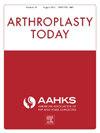在前路全髋关节置换术的股骨先入路中加入导航技术可改善腿长恢复效果
IF 1.5
Q3 ORTHOPEDICS
引用次数: 0
摘要
背景在直接前路(DAA)全髋关节置换术(THA)中增加计算机导航(CN)技术有可能改善髋关节偏移和腿长的恢复。在这项调查中,我们研究了一种基于透视的 CN 系统对股骨先露(FF)工作流程下 DAA THA 生物力学参数的影响。方法对 235 例初级 DAA FF THA 进行了回顾性审查,其中 CN 组 100 例,传统透视覆盖(FO)组 135 例。进行了放射学检查。影像学结果测量包括THA和原髋之间髋关节中心位置、股骨偏移、整体偏移和腿长的差异。术中和术后并发症也被记录在案。对连续数据采用t检验,对分类数据采用ꭓ2检验进行统计分析。结果虽然股骨偏移量和水平髋关节中心的各个部分存在差异,但CN组(平均:2.15毫米)和FO组(平均:1.85毫米)之间的总体偏移量平均差异没有统计学差异(P = .898)。异常值的数量在统计学上也不显著。与 FO 组(平均:2.26 毫米)相比,CN 组的平均腿长差异(平均:1.52 毫米)明显改善(P = .001),异常值分别为 1.09% 和 8.89%(P = .013)。CN技术对整体偏移无明显影响。CN组和FO组在并发症方面无明显差异。本文章由计算机程序翻译,如有差异,请以英文原文为准。
The Addition of Navigation Technology to the Femur-First Approach in Anterior Total Hip Arthroplasty Improves Leg Length Restoration
Background
The addition of computer navigation (CN) technology in direct anterior approach (DAA) total hip arthroplasty (THA) has the potential to improve restoration of hip offset and leg length. In this investigation, we examine the effect of one fluoroscopic-based CN system on biomechanical parameters in DAA THA with femur-first (FF) workflow.
Methods
A retrospective review was performed on 235 primary DAA FF THA cases, with 100 CN cases and 135 in the conventional fluoroscopic overlay (FO) group. Radiographic examination was performed. Radiographic outcome measures included differences in hip center position, femoral offset, global offset, and leg length between the THA and native hips. Intraoperative and postoperative complications were also documented. Statistical analysis was performed using a t test for continuous data and a ꭓ2 test for categorical data.
Results
While there were differences in individual components of femoral offset and the horizontal hip center, mean difference in global offset was not statistically different between the CN (mean: 2.15 mm) and FO (mean: 1.85 mm) groups (P = .898). The number of outliers was also statistically insignificant. The CN group demonstrated significant improvement in mean leg length discrepancy (mean: 1.52 mm) in comparison to the FO group (mean: 2.26 mm) (P = .001), with 1.09% and 8.89% of outliers, respectively (P = .013).
Conclusions
The addition of CN technology to DAA FF THA improved the accuracy and precision of restoring leg length. CN did not significantly affect global offset. There was no significant difference in complications between the CN and FO groups.
求助全文
通过发布文献求助,成功后即可免费获取论文全文。
去求助
来源期刊

Arthroplasty Today
Medicine-Surgery
CiteScore
2.90
自引率
0.00%
发文量
258
审稿时长
40 weeks
期刊介绍:
Arthroplasty Today is a companion journal to the Journal of Arthroplasty. The journal Arthroplasty Today brings together the clinical and scientific foundations for joint replacement of the hip and knee in an open-access, online format. Arthroplasty Today solicits manuscripts of the highest quality from all areas of scientific endeavor that relate to joint replacement or the treatment of its complications, including those dealing with patient outcomes, economic and policy issues, prosthetic design, biomechanics, biomaterials, and biologic response to arthroplasty. The journal focuses on case reports. It is the purpose of Arthroplasty Today to present material to practicing orthopaedic surgeons that will keep them abreast of developments in the field, prove useful in the care of patients, and aid in understanding the scientific foundation of this subspecialty area of joint replacement. The international members of the Editorial Board provide a worldwide perspective for the journal''s area of interest. Their participation ensures that each issue of Arthroplasty Today provides the reader with timely, peer-reviewed articles of the highest quality.
 求助内容:
求助内容: 应助结果提醒方式:
应助结果提醒方式:


